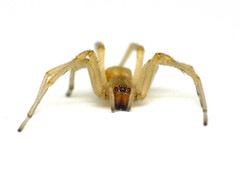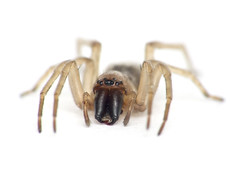 click for large
click for large
Generally I have to go out looking for the spiders I photograph, but this one was an exception. As I was doing some laundry, this one ran right over my foot. It was pretty large, about the size of a quarter, and very fast.
These spiders are often found in darker areas, such as flower beds, wood piles, and areas where they can weave a funnel-web. When it is found in homes, it often is found in the basement, in the darker recesses such as closets and corners. It is a nocturnal spider, so generally it is discovered when the lights are turned on and the spider darts for cover. These spiders are not seasonal, but rather, can be found year round, if in a survivable environment.
This species was imported from Europe into the shipping ports when large numbers of settlers immigrated from Europe (starting around the 1600s), and it has steadily spread throughout the United States and Canada.
This spider is not dangerous to people, but is often confused with the Hobo Spider of the same genus, Tegenaria agrestis, which may or may not be dangerous to humans. Unless you live in the northwest US, it's probably not a Hobo Spider. Look
here for the Hobo Spider's natural range. If you are unsure of the exact species, just be mindful of this confusion, and use caution when dealing with the spider.
Raynox DCR-250

mounted on my Panasonic Lumix FZ8.










